Clinical Practice Guideline (CPG) on Patellofemoral Pain

We are proud to announce the publication of the New Clinical Practice Guideline (CPG) on Patellofemoral Pain. We thank all the Authors, Editors, Reviewers, and the Journal of Orthopaedic and Sports Physical Therapy (JOSPT) for all their work in creating this invaluable resource.
For those who are unaware, patellofemoral pain is located in the knee. Symptoms are aggravated with certain load-bearing activities on the knee, such as squatting, sitting for prolonged periods of time, going up and down stairs, running, and jumping. This can greatly hinder a patient’s ability to function properly in their job, sport, or everyday life. If you are living with patellofemoral pain, physical therapy can undeniably help – and this CPG helps us stay up to date on the best practices.
Physical therapy and patellofemoral pain:
Many studies have been done on patellofemoral pain in the past, and physical therapy has always been listed as a safe and effective treatment method. For example, a 2017 study published by the National Institutes of Health, titled “Effectiveness of Manual Therapy Combined With Physical Therapy in Treatment of Patellofemoral Pain Syndrome: Systematic Review” used randomized controlled trials to test the efficacy of manual and physical therapy treatments for patients with patellofemoral pain.
The systematic review yielded positive results, verifying that manual and physical therapy treatments did indeed provide success in pain relief and improved function, especially with the strengthening of hip and knee muscles when applied to the full kinetic chain.
We mention this study, because even with proven and supported results from medical journals, it is still important to make sure we are employing the best practices for our patients. This clinical practice guideline helps us do so.
According to the CPG, “This CPG will allow physical therapists and other rehabilitation specialists to stay up-to-date with evolving PFP knowledge and practices and help them to make evidence-based treatment decisions.”
Clinical practice guideline highlights:
The very best physical therapy experts in the field were appointed by the Academy of Orthopaedic Physical Therapy and American Physical Therapy Association (APTA) to make this CPG happen.
These experts worked alongside research librarians who were trained in systematic review, in order to come up with a systematic search on topics regarding the classification, examination, and intervention strategies of patellofemoral pain. Databases were searched from 1960 up through 2018 and yielded the following highlights:
- Hip and knee exercises are the best resources for people living with kneecap pain.
- Knee taping or inexpensive shoe inserts can be helpful, but should be combined with an exercise program.
- There are no quick fixes: Exercise is the best mode of treatment over all other options.
Additional advice for patients was highlighted, such as:
- Gradually increasing the amount of activity you are doing.
- Doing a variety of activities – adolescents who specialize in a single sport have a greater risk of developing kneecap pain.
Contact Recovery Physical Therapy for the most effective relief:
At Recovery Physical Therapy in New York, NY, we work hard to constantly employ the newest, most effective, and most innovative methods of treatment into our practice. Clinical practice guidelines such as this one help us stay informed on the ever-changing world of physical therapy so we can provide the best possible treatment for our patients at all times.
Our licensed physical therapists are equipped with the most advanced and effective methods of treatment to aid in your patellofemoral pain recovery. If you are living with this pain, don’t hesitate to contact us today – we will be sure to get you started on the very best treatment plan for your needs.
